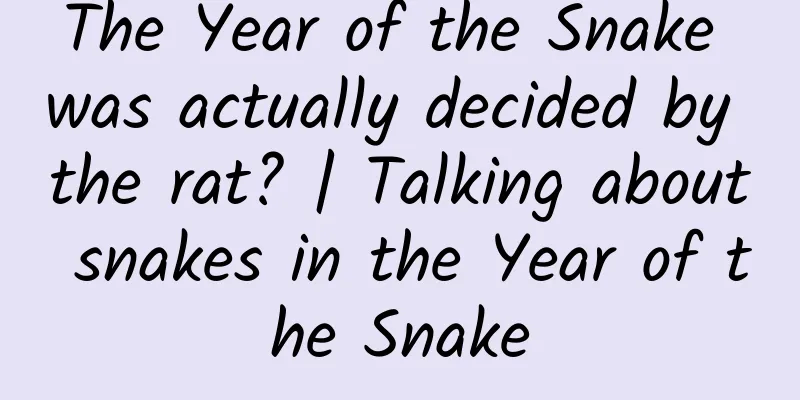The Year of the Snake was actually decided by the rat? | Talking about snakes in the Year of the Snake

|
The Spring Festival of the Year of the Snake is coming soon. Let's talk about an interesting little-known fact about snakes - there is an interesting term in paleontology called "the year of the snake is determined by the rat". How can the "year of the snake" be determined by the rat? Rat, ox, tiger, rabbit, dragon, snake, horse... In the order of the zodiac, aren't rats and snakes next to each other? Don't worry, let's ask Dr. Shi Jingsong, a doctoral student in the Department of Amphibians and Reptiles at the Institute of Vertebrate Paleontology and Paleoanthropology, Chinese Academy of Sciences, to reveal the mystery for us. 01 What does “Rat and Snake Year” mean? Literally, "rat determines the year of the snake" means that the rat determines the year of the snake? In fact, this term means that the age of snake fossils is determined by rats - this is a dating reference method commonly used in Cenozoic snake research. The approximate range of the stratigraphic age is determined by small rodents distributed in the same layer and age as snake fossils, thereby inferring the age of snake and other animal fossils. 02 Why must rats be used? Can’t other animals be used? What I mean is that there should be many animals living in the same era as snakes. Why don't we use larger animals to "date the year of the snake" instead of looking for small animals like mice? In fact, small rodents (rats) evolve quickly and can form a new group in tens of thousands of years. Therefore, the types of mammals in different strata and the composition of different species can well reflect the era and climate at that time . In addition to mice, other small mammals can also be used for dating. The specific situation should be analyzed according to the species composition in the fossil strata. 03 Classic case : The “Rat-Snake Year” in the Miocene of Linxia, Gansu The sand boa fossils in the Linxia Basin of Gansu Province were buried together with some bamboo rat fossils and were identified as indigenous false bamboo rats . Unlike the bamboo rats in the south today, indigenous false bamboo rats do not live in warm tropical areas and do not eat bamboo. Instead, they live in relatively arid grassland environments. The fossils of indigenous false bamboo rats are widely distributed in the upper part of the upper part of the Willow Formation of the Upper Miocene Bahe Stage , which means that they lived in the late Miocene 7 to 8 million years ago . Therefore, we can infer that the sand boa fossils in the Linxia Basin are also nearly 8 million years old. Sand anacondas currently living in Gansu, my country (Photo source: Screenshot from Science Popularization China video) 04 Compared to fossils of dinosaurs or mammals, why do we rarely hear about snake fossils? Is it because there are few discoveries? What is the significance of the discovery of snake fossils? The earliest confirmed snake fossils were recorded in the Middle Jurassic strata , about 160 to 170 million years ago. Since then, snake fossils have been found on almost every continent in the world. However, snake fossils seem to be much more low-key than dinosaur fossils and have received less attention. In fact, the snake fossil materials in the late Cenozoic (Neogene and Quaternary) strata in my country are very rich and have unique research value, which is specifically manifested in the following aspects: 1. Snakes have specialized bodies, and their skeletal morphology often reflects their specific diet and lifestyle; 2. As ectothermic animals, snakes have a unique response mechanism to climate and environmental changes. Their diversity can effectively reflect the ancient climate and ancient environment in which they lived at that time; 3. The stratigraphic age information contained in snake fossils is the key evidence for correcting the phylogenetic tree of related lineages . After all the fuss, this "Year of the Snake" is not the same as that "Year of the Snake"! However, it is amazing that the little mouse can play such an important role in paleontology. Finally, I wish everyone good luck in the Year of the Snake! Author: Shi Jingsong, PhD in Amphibians and Reptiles, Institute of Vertebrate Paleontology and Paleoanthropology, Chinese Academy of Sciences Produced by: Science Popularization China |
>>: The former "high-end fruit" has fallen from its pedestal this year. What happened?
Recommend
The colorful black, the ever-changing white, the brilliant green... have been passed down for 100,000,000 years?
Audit expert: Luo Huiqian Associate Researcher, I...
How much does it cost to develop a recipe mini program with home cooking functions?
As those born in the 1990s and 2000s have started ...
Electric Technology Car News: As a once leading model but now in decline, Tiguan L can still crush its rivals with its performance and space
Tiguan, once the leading model of joint venture S...
Apple will set off a new wave of smart hardware in 2015
Although the much-anticipated Apple Watch will no...
Three Mentality of Chinese People When Buying Mobile Phones
Buying a mobile phone is a complicated process. T...
A brief history of the imported term “404 error”: “The page you are looking for does not exist”
Editor's note: "404 error" is a web...
Approved without sensitive words, Toutiao and UC Toutiao frequently promote gambling apps
The agency promoted gambling apps on various plat...
How to buy real fans on Douyin? Where can I buy real fans on Douyin?
As technology becomes more and more powerful, mob...
PwC: Drones will soon replace $127 billion in human labor
For many people, drones are a wonderful gift or a...
Can't use WeChat Pay? Meituan responded: The payment system was abnormal and has been fully restored
[[401312]] On May 24, "Meituan cannot use We...
How much does it cost to open an account just for Baidu Union promotion?
(1). Baidu Union Promotion is a single account wi...
Case Study: Event Operations Planning Process
The online learning platform built based on moder...
When will the Qingdao epidemic end in 2022? When will it be unblocked? Attached the latest news
Recently, the first city in Shandong Province to ...
Will the robot dog "Benben" in "The Wandering Earth 2" appear on the battlefield?
During the Spring Festival this year, the Chinese...
Why did Douyin suddenly have no traffic? Why did Douyin's traffic suddenly drop to very little?
Now is the era where traffic is king. No matter w...









